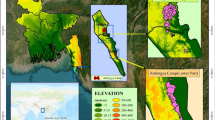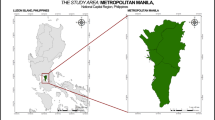Abstract
The society is constantly progressing, the population is increasing, and the pace of urbanization is getting faster and faster. However, while the city is developing rapidly, there are also problems of thermal environment. The most important part of solving the current environmental problems in the city is to strengthen the greening in the city. The solution of economic problems in the environment can promote the coordinated development of the city, thereby improving economic efficiency. The strength of the urban heat island has a certain relationship with the greening of the city. When the green area of the city is large, the heat island effect in the city is low, and the two are in a negative correlation. In the center of the city, the degree of economic development is relatively high, and people in areas with little land and little money are unwilling to use land where they cannot generate economic benefits. Therefore, vegetation coverage should be increased in urban centers, especially by planting some trees on both sides of the road to reduce the heat island effect. Planning for the urban environment should pay attention to the following two aspects: Firstly, for other types of land use, scientific planning should be done and the land should be used rationally. Secondly, in order to make the urban green space construction more systematic and the layout more reasonable, in the construction process, the various areas should be united to form a whole, so as to make the layout more reasonable and scientific. In this article, the author judges the surface temperature of the city by improving the neural network based on the data in the satellite remote sensing image. In the planning of the future environment of the green city, the author compared different evaluation systems in order to obtain more accurate results, mainly the two evaluation systems of statistical data and remote sensing data. After considering the advantages and disadvantages of different models, the parameters of the model were further improved, and the feasibility of the model was tested.













Similar content being viewed by others
Change history
06 December 2021
This article has been retracted. Please see the Retraction Notice for more detail: https://doi.org/10.1007/s12517-021-09175-9
28 September 2021
An Editorial Expression of Concern to this paper has been published: https://doi.org/10.1007/s12517-021-08471-8
References
Abbas Z, Ali S, Rizwan ZIE, Malik A, Riaz MA, Shahid MR, ur Rehman MZ, Al-Wabel MI (2018) A critical review of mechanisms involved in the adsorption of organic and inorganic contaminants through biochar. Arab J Geosci 11(16):448
Abbaspour A, Golchin A (2011) Immobilization of heavy metals in a contaminated soil in Iran using di-ammonium phosphate, vermicompost and zeolite. Environ Earth Sci 63:935–943
Bond-Lambert B, Thompson A (2010) Temperature-associated increases in the global soil respiration record. Nature 464:582–597
Bond-Lambert B, Bailey VL, Chen M, Gough CM, Vargas R (2018) Globally rising soil heterotrophic respiration over recent decades. Nature 560:80–83
Brassard BW, Chen HYH, Bergeron Y (2009) Influence of environmental variability on root dynamics in northern forests. Crit Rev Plant Sci 28:179–197
Chiu CC, Cheng CJ, Lin TH, Juang KW, Lee DY (2009) The effectiveness of four organic matter amendments for decreasing resin-extractable Cr(VI) in Cr(VI)-contaminated soils. J Hazard Mater 161(2–3):1239–1244
Glagolev MV, Ilyasov DV, Terentieva IE, Sabrekov AF, Mochenov SY, Maksutov SS (2018) Methane and carbon dioxide fluxes in the waterlogged forests of south and middle taiga of Western Siberia. IOP Conf Series: Earth and Environmental Science 138:012005. https://doi.org/10.1088/1755-1315/138/1/012005
Gordon AM, Schlentner RE, Van Cleve K (1987) Seasonal patterns of soil respiration and CO2 evolution following harvesting in the white spruce forests of interior Alaska. Can J For Res 17:304–310
Grogan P, Chapin FS III (1999) Arctic soil respiration: effects of climate and vegetation depend on season. Ecosystems 2:451–459
Hashimoto S, Carvalhais N, Ito A, Migliavacca M, Nishina K, Reichstein M (2015) Global spatiotemporal distribution of soil respiration modeled using a global database. Biogeosciences 12:4121–4132. https://doi.org/10.5194/bg-12-4121-2015
Huang M, Zhu Y, Li Z, Huang B, Luo N, Liu C, Zeng G (2016) Compost as a soil amendment to remediate heavy metal-contaminated agricultural soil: mechanisms, efficacy, problems, and strategies. Water Air Soil Pollut 227(10):359
Jordao CP, Pereira MDG, Einloft R, Santana MB, Bellato CR, VargasdeMello JW (2002) Removal of cu, Cr, Ni, Zn, and cd from electroplating wastes and synthetic solutions by vermicompost of cattle manure. J Environ Sci Health A 37:875–892
Kalaivanan D, Ganeshamurthy AN (2016) Mechanisms of heavy metal toxicity in plants. Abiotic Stress Physiology of Horticultural Crops 1:85–102
Masyagina OV, Prokushkin AS, Prokushkin SG (2009) Long-term soil respiration observations in burnt area (of 1994) and in adjacent larch stand in central Evenkia (Russia). In: C/H2O/Energy balance and climate over boreal regions with special emphasis on eastern Eurasia: Proceedings of 4th International WS. Yakutsk, Russia, Nagoya, pp 99–100
Masyagina OV, Evgrafova SY, Titov SV, Prokushkin AS (2015) Dynamics of soil respiration at different stages of pyrogenic restoration succession with different-aged burns in Evenkia as an example. Russ J Ecol 46(1):27–35
Masyagina OV, Evgrafova SY, Bugaenko TN, Kholodilova VV, Krivobokov LV, Korets MA, Wagner D (2019) Permafrost landslides promote soil CO2 emission and hinder C accumulation. Sci Total Environ 657:351–364. https://doi.org/10.1016/j.scitotenv.2018.11.468
Matvienko AI, Makarov MI, Menyailo OV (2014) Biological sources of soil CO2 under Larix sibirica and Pinus sylvestris. Russ J Ecol 3:174–180
Prokushkin AS, Tokareva IV, Prokushkin SG, Abaimov AP, Guggenberger H (2008) Fluxes of dissolved organic matter in larch forests in the cryolithozone of central Siberia. Russ J Ecol 39:151–159
Prokushkin AS, Hagedorn F, Pokrovsky OS, Viers J, Kirdyanov AV, Masyagina OV, Prokushkina MP, McDowell WH (2018) Permafrost regime affects the nutritional status and productivity of larches in Central Siberia. Forests 9:1–18
Qu LY, Kitaoka S, Koike T (2018) Factors controlling soil microbial respiration during the growing season in a mature larch plantation in Northern Japan. J Soils Sediments 18:661–668. https://doi.org/10.1007/s11368-017-1799-9
Raich JW, Potter CS (1995) Global patterns of carbon dioxide emissions from soils. Glob Biogeochem Cycles 9:23–36
Santruckova H, Bird M, Kalaschnikov YN, Grund M, Elhottova D, Simek M, Grigoriev SA, Gleixner G, Arneth A, Schulze D, Lloyd J (2003) Microbial characteristics of soils on a latitudinal transect in Siberia. Glob Chang Biol 9(7):1106–1117. https://doi.org/10.1046/j.1365-2486.2003.00596.x
Sawamoto T, Hatano R, Yajima T, Takahashi K, Isaev AP (2000) Soil respiration in Siberian taiga ecosystems with different histories of forest fire. Soil Sci Plant Nutr 46:31–42
Schulze E-D, Lloyd J, Kelliher FM et al (1999) Productivity of forests in the Eurosiberian boreal region and their potential to act as a carbon sink – a synthesis. Glob Chang Biol 5:703–722
Schulze E-D, Wirth C, Mollicone D, von Lüpke N, Ziegler W, Achard F, Mund M, Prokushkin A, Scherbina S (2012) Factors promoting larch dominance in central Siberia: fire versus growth performance and implications for carbon dynamics at the boundary of evergreen and deciduous conifers. Biogeosciences 9:1405–1421. https://doi.org/10.5194/bg-9-1405-2012
Wang Q, He N, Xu L, Zhou X (2018) Microbial properties regulate spatial variation in the differences in heterotrophic respiration and its temperature sensitivity between primary and secondary forests from tropical to cold-temperate zones. Agric For Meteorol 262:81–88. https://doi.org/10.1016/j.agrformet.2018.07.007
Whittaker RH (1975) Communities and ecosystems, 2nd Revise edn. MacMillan Publishing Co, New York
Yvan-Durocher G, Caffrey JM, Cescatti A, Dossena M, del Giorgio P, Gasol JM, Montoya JM, Pumpane J, Staehr PA, Trimmer M, Woodward G, Allen AP (2012) Reconciling the temperature dependence of respiration across timescales and ecosystem types. Nature 487:472–476. https://doi.org/10.1038/nature11205
Zhao Z, Peng C, Yang Q, Meng F-R, Song X, Chen S, Epule TE, Li P, Zhu Q (2017) Model prediction of biome-specific global soil respiration from 1960 to 2012. Earth’s Future 5:715–729. https://doi.org/10.1002/2016EF000480
Zhou T, Phi P, Hui D, Luo Y (2009) Global pattern of temperature sensitivity of soil heterotrophic respiration (Q10) and its implications for carbon-climate feedback. J Geophys Res Biogeosci 114:G02016
Acknowledgement
Yeung Lapfu is the PHD candidate in China University of Political Science and Law.
Author information
Authors and Affiliations
Corresponding author
Ethics declarations
Conflict of interest
The authors declare that they have no competing interests.
Additional information
Responsible Editor: Sheldon Williamson
This article is part of the Topical Collection on Environment and Low Carbon Transportation
This article has been retracted. Please see the retraction notice for more detail: https://doi.org/10.1007/s12517-021-09175-9
About this article
Cite this article
Lap-fu, Y. RETRACTED ARTICLE: Environmental planning and economic efficiency of green cities based on improved neural network and satellite remote sensing. Arab J Geosci 14, 1399 (2021). https://doi.org/10.1007/s12517-021-07657-4
Received:
Accepted:
Published:
DOI: https://doi.org/10.1007/s12517-021-07657-4




